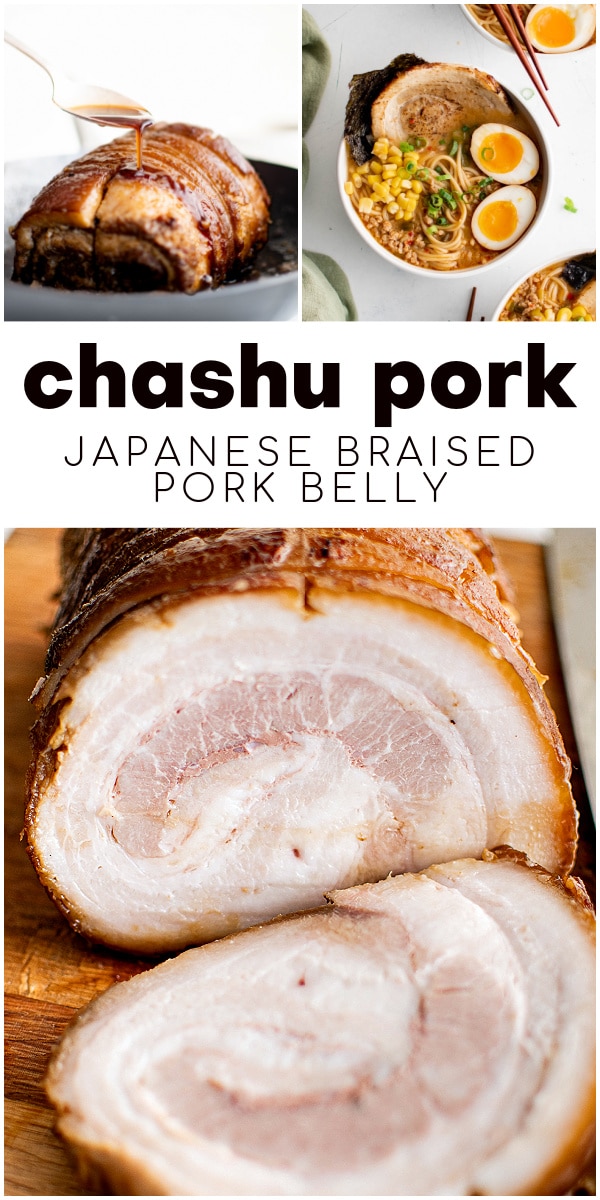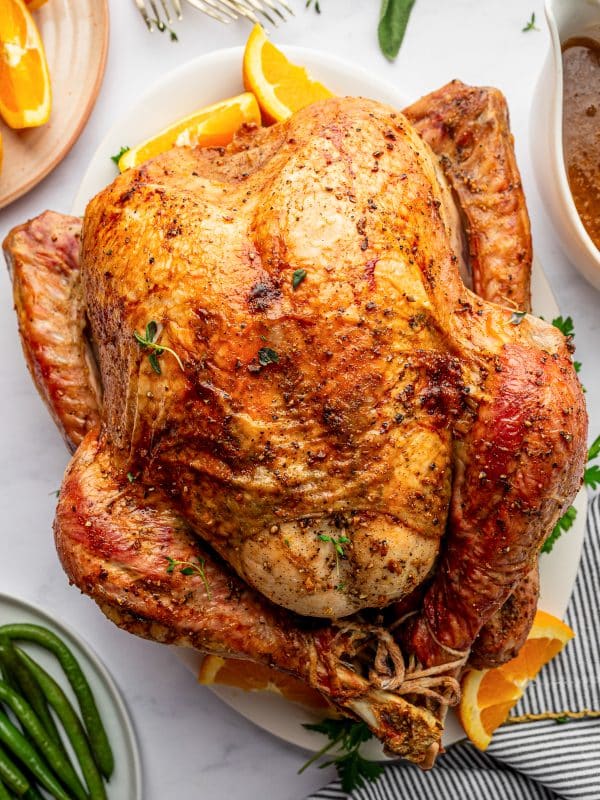This post may contain affiliate links. See my disclosure policy.
Learn how to make this tender, melt-in-your-mouth Chashu Pork Recipe at home! Made with marinated and rolled pork belly braised in a sweet and savory combination of fresh ginger, mirin, soy sauce, and sake, it’s the perfect ramen topping.
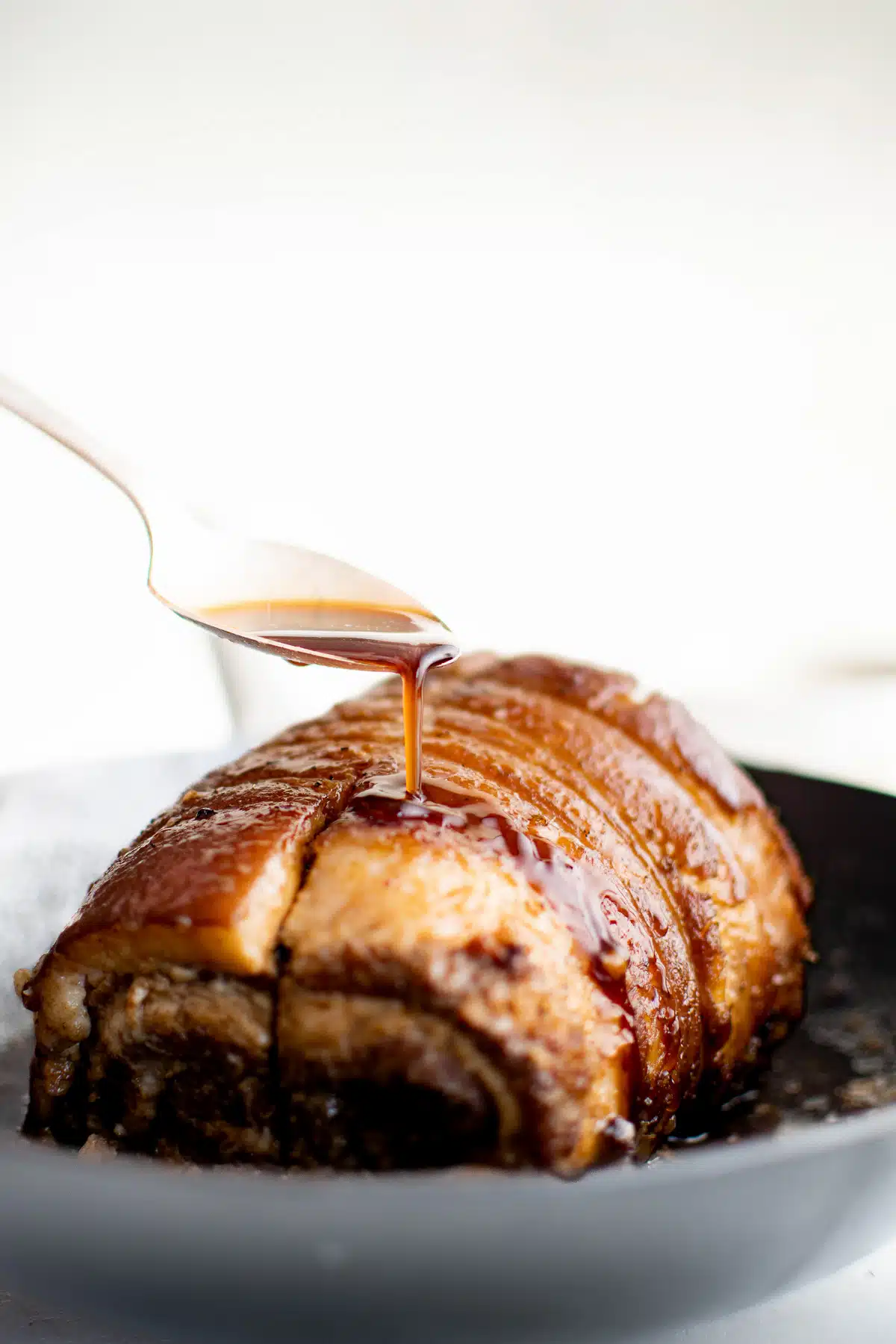
Ramen wouldn’t be the same without tender, buttery, melt-in-your-mouth Chashu pork. Fatty and flavorful, this Japanese classic may be a process to make at home, but quite simple overall and totally worth it. Let’s make some!
Table of Contents
What is Chashu Pork?
Chashu pork is a flavorful, rolled pork belly dish popular in Japanese cuisine, particularly as a topping for ramen. The term chāshū (チャーシュー) is a Japanese adaptation of the famous Chinese barbecued pork, Char Siu (叉燒). The original Chinese version, which requires roasting over high heat, is quite different from the Japanese style of slowly braising over low heat in a sauce made with mirin, sake, and soy sauce. After the pork is cooked, it’s cooled and then sliced into thin rounds. The combination of the savory, sweet, and slightly fatty flavors of the Chashu pork pairs well with the rich broth of ramen.
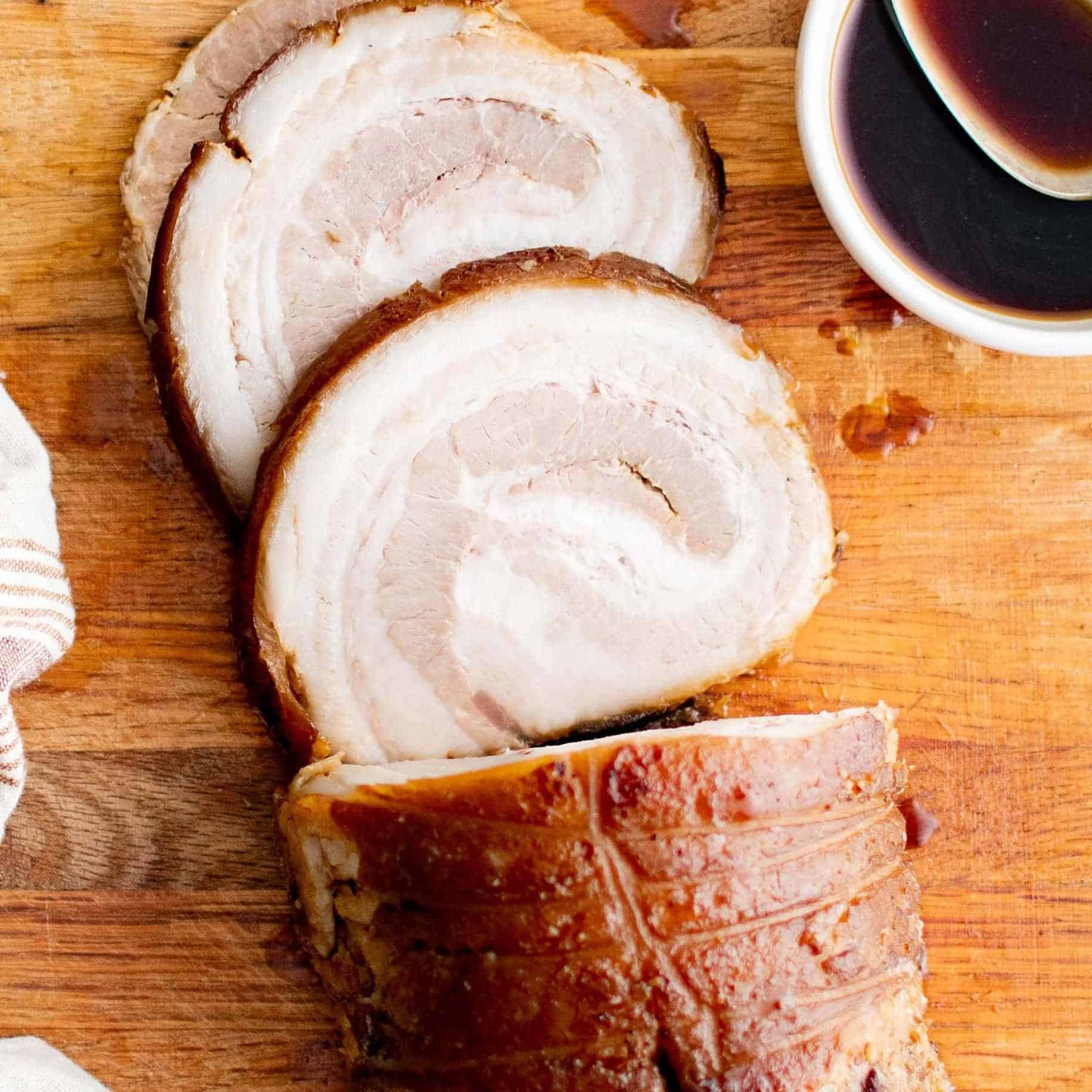
Chinese Char Siu vs. Japanese Chashu
Char Siu and Chashu, while sounding similar and both using pork, represent two distinct cooking styles from different culinary traditions: Chinese and Japanese, respectively.
- Char Siu (叉燒): A type of barbecued pork in Cantonese cuisine. The pork (often shoulder or loin cuts) is marinated in a mixture of honey, five-spice powder, fermented tofu (red bean curd), dark soy sauce, hoisin sauce, and red food coloring before being roasted in an oven or over an open fire. The result is a dish that is sweet, savory, and slightly spicy, with a signature red exterior and a slightly charred surface.
- Chāshū (チャーシュー): A dish often used as a topping for ramen in Japanese cuisine. It typically involves pork belly that is rolled into a log shape and then slow-cooked or braised in a mixture of soy sauce, mirin, sake, and sugar. Chashu is not barbecued, and the result is a very tender, savory, and slightly sweet pork with a soy-based glaze.
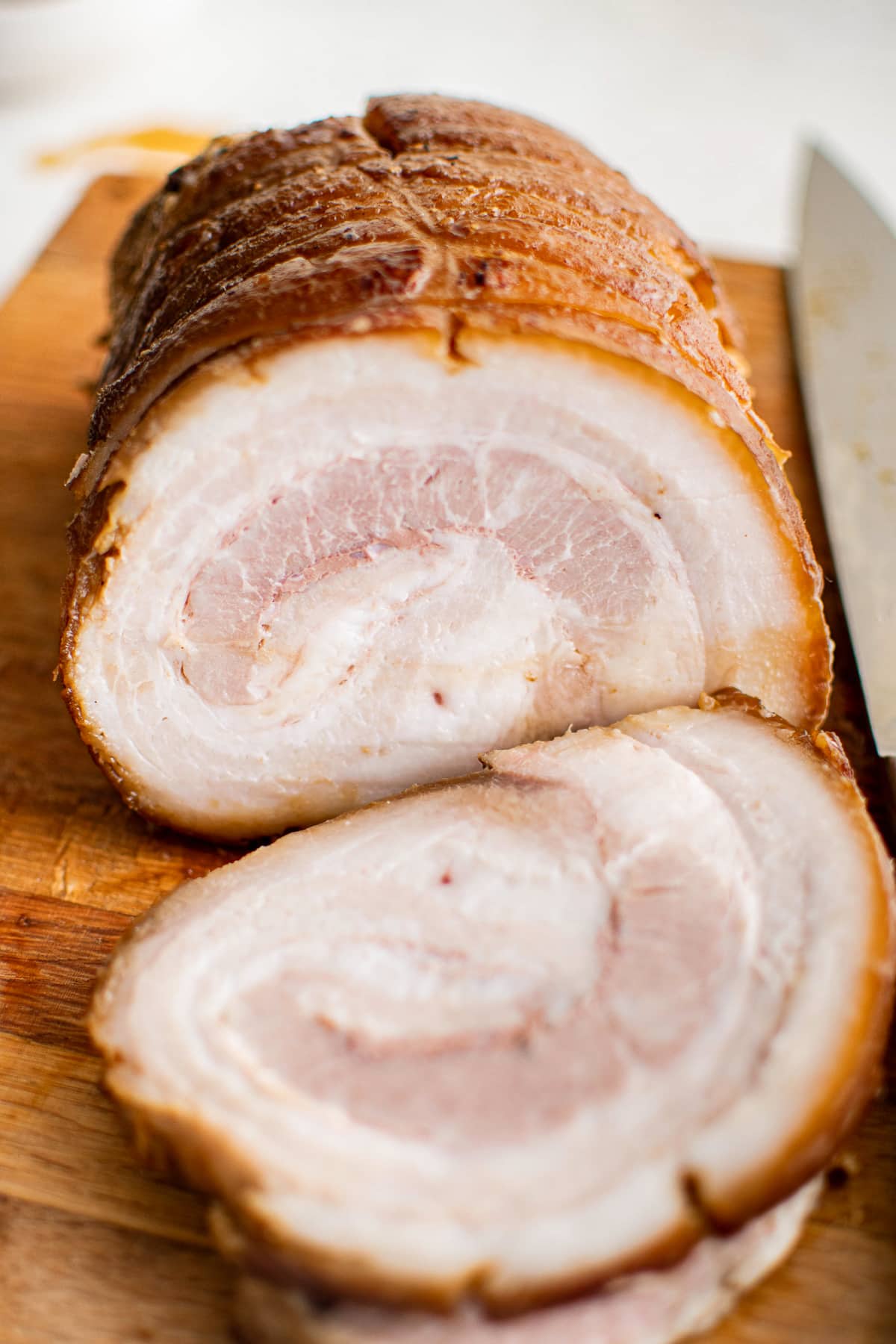
Ingredients in Chashu Pork
- Pork Belly: This is the most commonly used cut of meat for chashu due to its balance of meat and fat, resulting in a tender, flavorful result.
- Soy Sauce: As a core element of the braising liquid, soy sauce adds a deep umami flavor.
- Sake: Used in the braising liquid, sake adds a bit of sweetness and helps tenderize the meat.
- Mirin: This sweet rice wine is another component of the braising liquid, adding sweetness and depth of flavor.
- Sugar: We’re using granulated sugar, but brown sugar can also be used. It helps with the sweet-savory balance of the dish.
- Garlic, Ginger, and Onion: Added to the braising liquid for additional flavor.
- Water: Used to dilute the braising liquid, ensuring the pork isn’t overly salty.
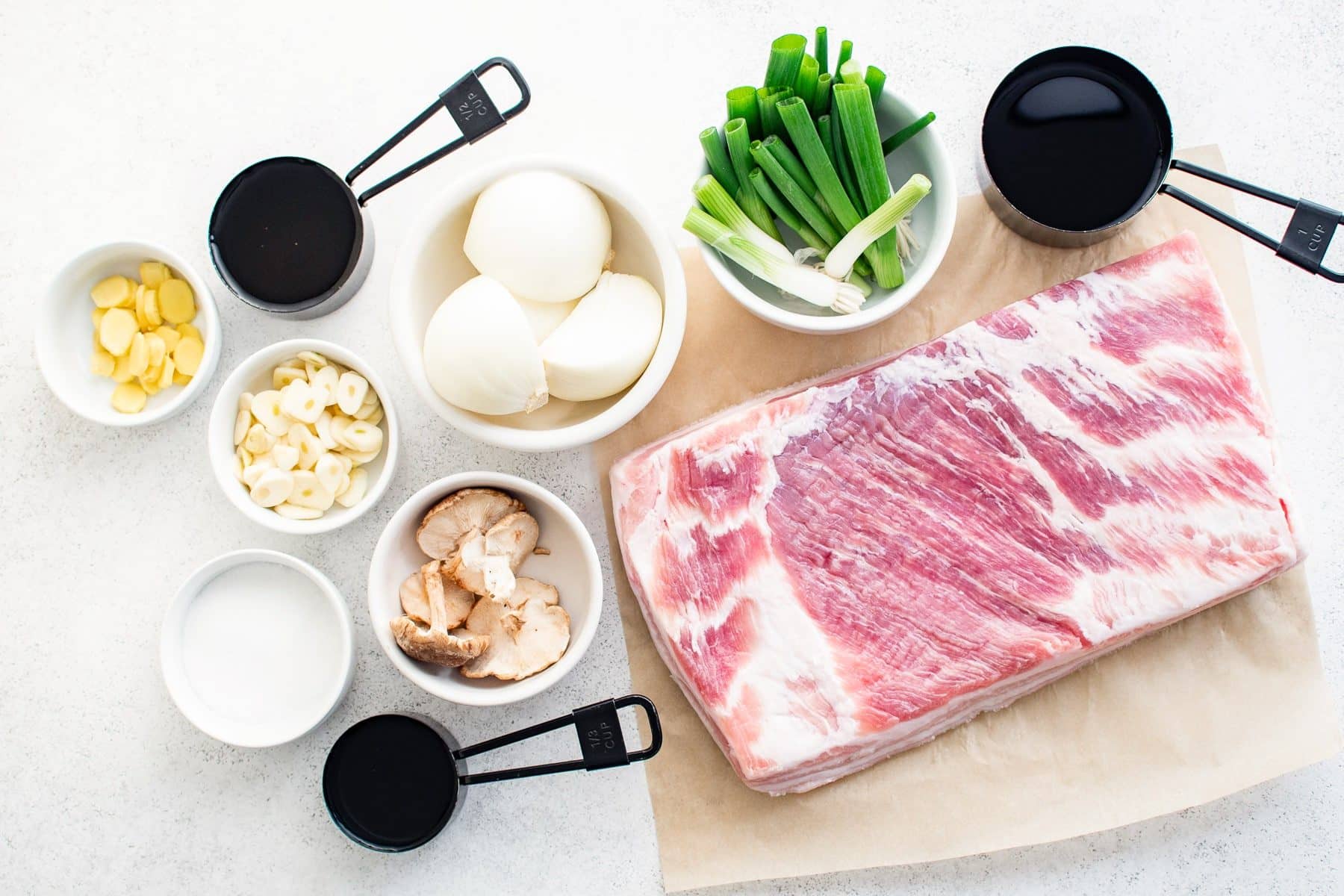



How to Tie Pork Belly for Chashu Pork
Here is how to prepare and roll pork belly for this Chashu pork recipe:
- Prepare the Pork Belly: Lay your pork belly out on a clean cutting board, skin-side down. If there are any seasonings you want to add directly to the meat, now is the time to do it. Traditional Chashu doesn’t typically have seasonings on the meat itself, as the flavor mostly comes from the braising liquid.
- Roll the Pork Belly: Starting on one long side, roll up the pork belly as tightly as you can. Aim to make the roll as uniform as possible so the cooking will be even.
- Tie the Roll: Take a length of kitchen twine that’s long enough to wrap around the length of the pork belly several times. Hold one end of the twine underneath the roll near one end, then bring the long end over the roll, loop it under itself, and pull tight to secure it. This will form a loop around the roll.
- Add More Twine: Move about an inch down the roll and repeat the process, looping the twine around the roll and pulling it tight. Continue this process until the whole roll is secured, ideally at intervals of about 1/2 to 1 inch.
- Secure the Ends: When you reach the end of the roll, loop the twine around the end a couple of times and tie a knot to secure it.
- Trim Excess Twine: If there’s a lot of extra twine, trim it off with a pair of kitchen scissors.
- Tie with a Second Piece of Twine: Cut a separate long piece of twine and weave it horizontally in and out of the vertical strings, then tie it off and cut any excess string off.






How to Make Chashu Pork
1. Prepare and tie the pork belly: See the step-by-step instructions outlined above. You may also try asking your butcher if they will tie it for you (I’ve had luck with some very helpful butchers at my local Whole Foods in the past).
2. Blanch the pork belly: Place the rolled pork belly in a large pot or Dutch oven and cover it with cold water. Bring to a boil for 10 minutes, then remove the pork, drain the water, and rinse the pot. Why do this? Blanching the pork helps to remove any scum and excess blood before cooking. You may recall that we blanch the bones before officially cooking them when we make bone broth.


3. Add the pork belly and aromatics to the pot: Return the pork belly to the pot and add the garlic, green onions, mushrooms, sugar, quartered onion, ginger, mirin, soy sauce, and sake. Fill with just enough water that the pork is nearly covered.
4. Braise the pork: Bring the liquid to a boil before reducing the heat to a simmer. Partially cover the pot with a lid and cook for 1.5 hours. (Note: In this case, it is possible to overcook chashu pork. Cooking longer does not translate to more tender meat.)



5. Remove the pork and strain the cooking liquid: Remove the braised pork belly from the pot and let it cool completely. As the pork belly is cooling, strain the cooking liquid left behind in the pot through a fine mesh strainer or sieve into a clean bowl. Discard any solids.
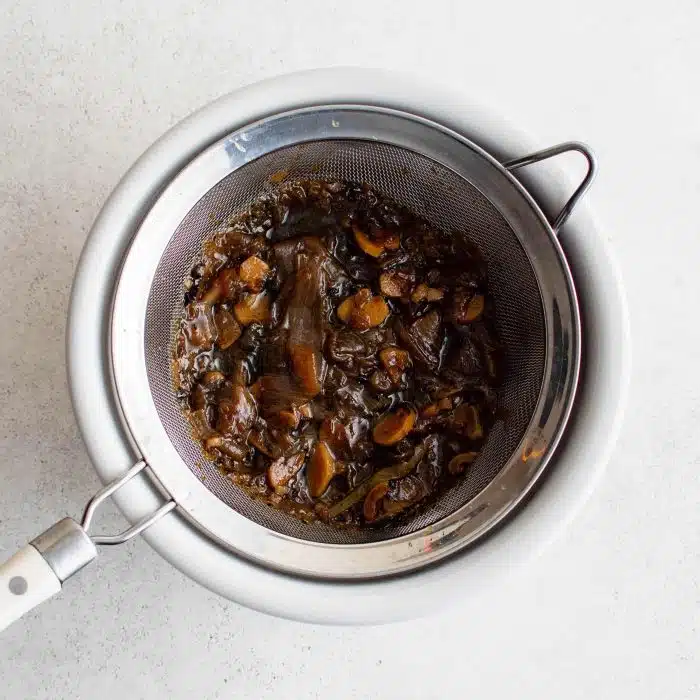

6. Marinate overnight: Once the chashu pork has cooled completely, transfer it to a large resealable bag. Pour in enough strained liquid to coat the pork. Remove as much air from the bag as possible, seal it, and transfer it to the refrigerator to chill overnight. (Transfer any excess broth to an airtight jar or container and keep it stored in the refrigerator. Reheat on the stovetop for serving.)

7. Sear the Chashu pork: The next day, remove the Chashu from the refrigerator and take the pork out of the bag. Reserve any broth left over in the bag for serving. Sear the pork belly in a large skillet over medium-high heat for 6-8 minutes, turning every 1-2 minutes, until it’s a deep golden brown on all sides. Cut the strings.
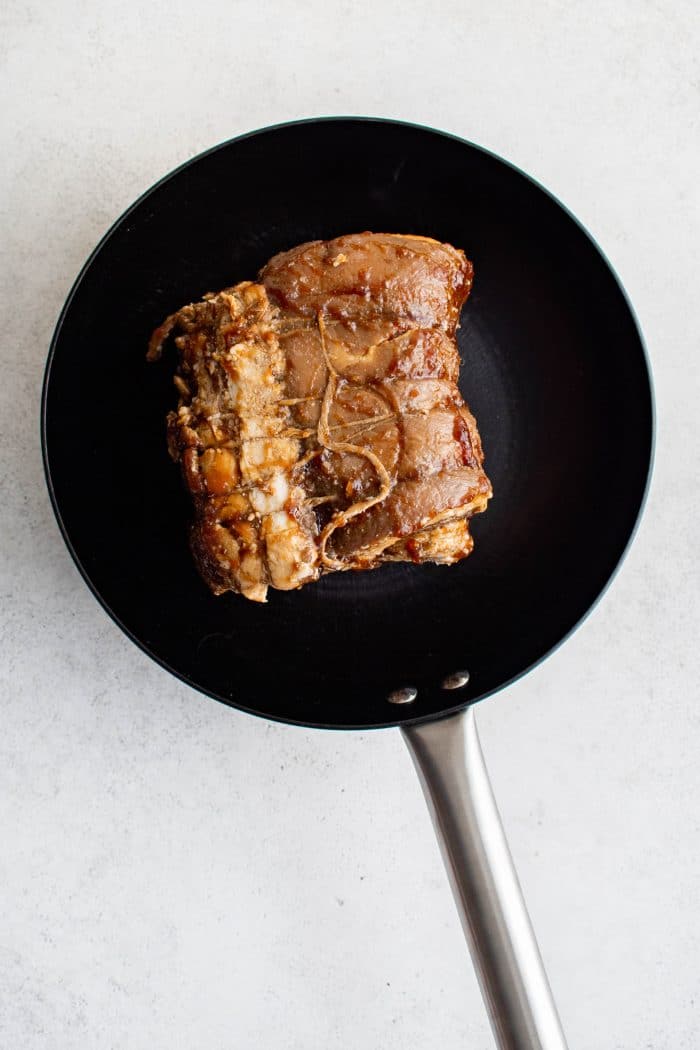


8. Thinly slice: Remove from the skillet and let it rest on a cutting board for 10 minutes, then slice into thin slices.

How to Serve Chashu Pork
Chashu pork is most commonly served as a topping for ramen, but it can be used in a variety of ways. Here are a few ideas:
- Ramen Topping: Slice the chashu pork into thin rounds and place them on top of a bowl of ramen. The rich, savory flavor of the pork pairs perfectly with the soup and noodles.
- Rice Bowl (Chashu Don): Make a chashu pork rice bowl by serving slices of chashu over steamed rice. You can add some of the reduced braising liquid as a sauce and garnish with green onions or pickled ginger.
- Bao Buns: You can use slices of chashu pork as a filling for bao buns.
- Sushi Rolls: For an unconventional sushi roll, try using slices of chashu pork. The savory flavor of the pork works well with sushi rice and nori.
- Onigiri: Make a Japanese rice ball, or onigiri, and use a piece of chashu pork as the filling.
- Stir-fry or Fried Rice: Cut the chashu pork into smaller pieces and use it in a stir-fry. It can add a punch of flavor to a simple vegetable stir-fry.

Leftovers and Freezing
Leftovers: Allow the chashu pork to cool to room temperature. Slice the leftover chashu into thin slices (if you haven’t done so already) as this makes it easier to reheat later. Place the sliced chashu in an airtight container with a little bit of the cooking liquid over the top to keep it moist. Store in the refrigerator for about 3-4 days.
Freezing: Allow the chashu pork to cool to room temperature. Slice the leftover chashu into thin slices (if you haven’t done so already). Lay the slices out on a baking sheet lined with parchment paper, making sure they aren’t touching, then place the sheet in the freezer. Once the slices are frozen, transfer them to a zip-top freezer bag or an airtight container. This method prevents the slices from sticking together. Store in the freezer. The chashu should last for about 1-2 months. Thaw in the refrigerator overnight before reheating.

More Asian-Inspired Recipes:
- Easy Edamame Recipe
- Beef and Broccoli Recipe
- Kung Pao Chicken
- Mongolian Beef
- Bok Choy Recipe
- Moo Goo Gai Pan Recipe
- Baked Teriyaki Chicken Recipe
If you try making this Chashu Pork Recipe, please leave me a comment and let me know! I always love to hear your thoughts.

Chashu Pork Recipe
Ingredients
- 3 pounds pork belly, with or without the skin on
- 3 cloves garlic, sliced
- 3 green onions, chopped into thirds
- 3 shiitake mushrooms, fresh or dried
- 2 tablespoon granulated sugar
- 1 yellow onion, peeled and quartered
- 1 (1-inch) piece fresh ginger, peeled and sliced
- ½ cup mirin
- ½ cup soy sauce
- ¼ cup sake
Instructions
Day 1
- Roll the pork belly into a tight roll with the skin or fat side out and secure it with cooking twine by twisting the twine around the top of the pork belly, knotting it then tightening and repeating to create vertical strings to secure the pork, then tie off the end.
- Cut a separate long piece of twine and weave it horizontally in and out of the vertical strings, then tie it off and cut any excess string off.
- Place the rolled pork belly in a large pot or Dutch oven and cover with cold water. Bring to a boil and cook for 10 minutes. Remove the pork, drain the water, and rinse the pot. (This process helps to remove any scum and excess blood before cooking.)
- Return the pork belly to the pot and add the garlic, green onions, mushrooms, sugar, quartered onion, ginger, mirin, soy sauce, and sake before filling with just enough water that the pork belly is nearly covered.
- Bring it to a boil, then reduce the heat to a simmer, partially cover the pot with a lid then cook for 1 1/2 hours.
- Remove the pork belly from the pot and let it cool completely. As the pork belly is cooling, strain the cooking liquid through a fine mesh strainer or sieve into a bowl. Discard any solids.
- Once completely cool, add the Chashu to a large resealable bag and pour in enough strained liquid to coat the pork. Remove as much air from the bag as possible, seal it, and transfer it to the refrigerator to chill overnight. (Save any excess broth for serving.) *See notes
Day 2
- The next day remove the Chashu from the refrigerator and take the pork out of the bag. Reserve any broth leftover in the bag.
- Heat a large pan or skillet over medium-high heat. Place the pork belly directly onto the skillet without any oil and sear for 6-8 minutes, turning every 1-2 minutes, until it's a deep golden brown on all sides, then cut the strings.
- Remove from the skillet and let it rest on a cutting board for 10 minutes, then slice into thin slices and serve with the reserved broth, fried rice, or your favorite bowl of ramen noodles.
Notes
Nutrition
Nutrition information is automatically calculated, so should only be used as an approximation.
